Sienna Sip and Stroll: Pinot Gringos and All Their “Trick Wines”
Entry 2 from the Grand Wine and Food Affair
I was aware at the Grand Wine and Food Affair’s grand tasting held the previous evening that summer was arriving in the Houston area. It came with a big wet clap of thunder while I was pouring my “Pick Six” Texas wines (https://vintagetexas.com/?p=738). If budding of wildflowers signaled the lead-up to the Hill Country Wine and Food Festival, the debut of hot heavy Houston weather usually means the best Not-So-Lil’ festival in Southeast Texas is at hand.
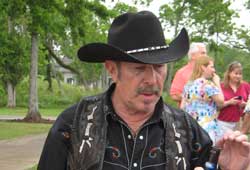 When I arrived at the Saturday Sienna Sip and Stroll under heavy moisture-laden air, I was glad that I had come appropriately dressed; shorts, cool cotton shirt with its tail hanging, and a large straw Panama hat with umbrella in tote. When I arrived, I peeked into the three large white tents that dotted the open Sienna Plantation grounds in Missouri City confirming they were full of delectable gastronomic delights and titillating wines. Next to the Sip and Stroll tent city were two additional smaller tents. One was dubbed “The Cigar Club” where attendees met with world class cigar makers. These cigar aficionados even got to toke with black clad Kinky Friedman, Texas’s eclectic singer, songwriter, novelist, humorist, columnist and politician (www.kinkyfriedman.com).
When I arrived at the Saturday Sienna Sip and Stroll under heavy moisture-laden air, I was glad that I had come appropriately dressed; shorts, cool cotton shirt with its tail hanging, and a large straw Panama hat with umbrella in tote. When I arrived, I peeked into the three large white tents that dotted the open Sienna Plantation grounds in Missouri City confirming they were full of delectable gastronomic delights and titillating wines. Next to the Sip and Stroll tent city were two additional smaller tents. One was dubbed “The Cigar Club” where attendees met with world class cigar makers. These cigar aficionados even got to toke with black clad Kinky Friedman, Texas’s eclectic singer, songwriter, novelist, humorist, columnist and politician (www.kinkyfriedman.com).
The remaining tent was for my Texas wine panel titled, “Pinot Gringos – Texas Grown, Texas Savored”. As moderator, the title of the panel was left up to me. Several people that day asked me about my choice of names. My answer was simply that it just came to me in a dream, which is where it actually found me. I told the crowd, “Admittedly, Texas does not have a reputation for Pinot Noir. However, Pinot Grigio grows very well here and, in Texas, there are plenty of Gringos and some Gringas, too. In reality, some are getting a reputation for making world-class wines.”
Our panel was a celebration of the Texas winemakers exploring Texas terroir with classic grape varietals and new warm weather varietals that are finding a place in the Texas countryside. The line-up for the afternoon’s wine tasting panel included four Texas wineries and eight wines:
John Bratcher (McPherson Cellars – www.mcphersoncellars.com) – featuring McPherson Cellars 2007 Viognier, and McPherson Cellars 2006 Sangiovese
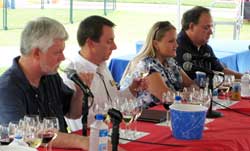 Greg the Texas Wine Guy (Alamosa Cellars – www.alamosawinecellars.com) – featuring 2008 Alamosa Scissortail, a white blend, and 2006 Alamosa Palette, a Rhone style red blend
Greg the Texas Wine Guy (Alamosa Cellars – www.alamosawinecellars.com) – featuring 2008 Alamosa Scissortail, a white blend, and 2006 Alamosa Palette, a Rhone style red blend
Marnelle Durrette (Kiepersol Estates – www.kiepersol.com) – featuring 2006 Kiepersol Syrah, and 2008 Kiepersol Estates Vit, a white blend
Sam Clark (Messina Hof Winery – www.messinahof.com) – Featuring 2007 Messina Hof Merrill’s Vineyard Riesling, and 2003 Paulo Port
From this list, you can see that each winery presented a white and red wine. The first five wines were dry, with final three wines showing increasing levels of sweetness.
I opened the panel by relating an interesting personal experience that highlights how blogs are changing the ‘landscape’ for Texas wines. As I related to the attendees, “Back in December, I opined on my VintageTexas blog that making world-class wines in Texas should not seem strange. If you listen to grower Neal Newsom describe the Texas High Plains red sandy soil (Tierra Rioja) and compare it with that of the Australian Coonawarra wine country famous for big Cabernets, it seems quite logical to expect the deep rich Cabernets, Merlots and Tempranillos that he and other growers have been getting in that part of Texas.”
I continued my saga by saying, “The next day I was the topic of a wine writer’s blog in Sidney, Australia where he gave me the title of ‘Texas WineSlinger’ and touted that Texas had gotten a case of ‘Coonawarra Envy’. Such is the way of the new global microcosm called the blogosphere…..so big, yet so small. It is almost like we were talking across our backyard fence.” For more info on this exchange, go to: https://vintagetexas.com/?p=402.
Pinot Gringos Wine Panel
McPherson Cellars – John Bratcher described his longstanding relationship with winemaker Kim McPherson at McPherson Cellars in Lubbock, Texas. Kim’s father “Doc” McPherson was one of the prime movers of the modern Texas wine industry in the 1970s. Kim was trained from early adulthood to continue his father’s leadership of the Texas wine industry. He garnered winemaking experience in California and then came back to Texas to help transition this state to classic European grape varieties with a focus on warm weather grape varietals.
John presented McPherson Viognier, a dry white wine infused with characteristics of peaches and apricots. John said, “Viognier does exceptionally well in Texas and is looking like it will be our leading white wine that pairs well with a range of seafood and even Asian cuisine.” My experience with this wine is that it is so fruit laden that people that normally only like sweet wines seem to enjoy it even though it is totally dry (no residual sugar).
John next presented McPherson Sangiovese, McPherson’s flagship red wine. Some of the first Sangiovese in Texas came from Doc McPherson’s efforts in the 1980s. This grape of Tuscany and the major component of Chianti wines gave rich cherry and red berry qualities. John said, “Dallas cheesemaker Paula Lambert is very particular with wines served with her cheeses, but particularly likes this Sangiovese with her hard aged goat cheese.” As John and I learned last weekend at the Hill Country Wine and Food Festival, this wine also goes very well with tomato-based soups and cuisine.
Alamosa Wine Cellars – Greg (Haug), “The Texas Wine Guy”, related that he first made contact with Jim and Karen Johnson, owner’s of Alamosa about 10 years ago at their “World Headquarters” in Bend, Texas (near San Saba). At that point in time, the Alamosa tasting room was nothing more than a folding card table, but things have changed and a modern facilities and tasting room now exists at the winery. Per Greg, “Alamosa Cellars doesn’t do conventional varietals such as Chardonnay, Merlot and the like. They focus on warm weather grape varietals, many that originate from the Mediterranean region of Europe, including Southern France, Spain and Italy.”
Greg presented Alamosa Scissortail (named after the indigenous bird in the Texas). It was a blend of three Mediterranean white varietals – Roussanne, Marsanne and a splash of Viognier that yielded light, creamy and toasty flavors. My personal thought is that people that say they are Chardonnay drinkers would really love this wine. The second wine presented was Alamosa Palatte, their premium red wine. Greg interestingly related, “This wine is a true field blend of Syrah, Mourvedre, Cinsault, and a little Viognier for good measure. The grapes were picked, crushed and co-fermented giving complex qualities of red berries and spice with a long finish.”
Kiepersol Estates – Marnelle Durrette, owner and winemaker at Kiepersol Estate said, “As most wineries, we started really small back in 1999 with a fourteen acre vineyard and slowly increased to our current size of sixty acres. Initially, it contained Cabernet Sauvignon, Merlot, Syrah and Barbara. Only the Barbara did not work out well for our site. Many people told me that classic vinifera grapes could not be grown on this site; but, after my first harvest I knew that I could make excellent wines from the grapes from my estate vineyard”.
Marnelle presented her Kiepersol Estate Syrah, a blend of different lots harvested and fermented separately then blended together and oak aged. It yielded dark berry essence, soft tannins, a smoky note and an easy drinking quality. Her second wine was called “Vit”, which means “white” in Afrikaans. This wine was made from her first commercial harvest of Sauvignon Blanc that she combined with Semillon and Pinot Grigio. It was originally developed for the Keipersol tasting room where she readily admits “sweeter palates prevail”. However, her Vit gave an appealingly light touch of sweetness balanced with crisp citrus acidity.
Messina Hof Winery – Sam Clark has worked in wine and wholesale distribution for over thirty years and has seen the evolution of Texas wines from mediocre to some of the best in the world. Sam highlighted a marketing study that recently showed that wine consumption in Texas was outpacing that of beer. This milestone, that most found surprising, bodes well for further growth in sales of Texas wines. Sam said, “Texas wines are increasing prevalent at social functions, and more Texas wines are sold in Texas than wines from some of the major wine producing regions. The big push now needs to get more coverage of Texas wines in restaurants around the state, and this will require consumers to ask for them where they dine.”
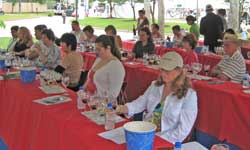 The first wine that Sam presented was the Messina Hof single vineyard Merrill’s Vineyard Riesling from their vineyard located in Half Way in the Texas High Plains (northwest Texas near Lubbock). He explained, “Even though having a good bit of sweetness, this wine is pleasingly fresh and crisp making it a good foil for just about any spicy food.” The second wine, Paulo Port, made from one hundred percent Lenoir (Aka: Black Spanish) grapes was made without fortification with brandy, as would be the case with conventionally produced Port wines. A special yeast was used that can handle fermentation up to higher alcohol levels making the brandy addition not necessary. The results were a powerful dark berry flavored wine yet appealingly smooth.
The first wine that Sam presented was the Messina Hof single vineyard Merrill’s Vineyard Riesling from their vineyard located in Half Way in the Texas High Plains (northwest Texas near Lubbock). He explained, “Even though having a good bit of sweetness, this wine is pleasingly fresh and crisp making it a good foil for just about any spicy food.” The second wine, Paulo Port, made from one hundred percent Lenoir (Aka: Black Spanish) grapes was made without fortification with brandy, as would be the case with conventionally produced Port wines. A special yeast was used that can handle fermentation up to higher alcohol levels making the brandy addition not necessary. The results were a powerful dark berry flavored wine yet appealingly smooth.
You said “Trick Wines”?
I believe that the best comment from the day’s panel was made by John Bratcher who mentioned a discussion he had with a man at a wine tasting several years ago. This man asked John if the wines John was pouring were “trick wines”. John stopped and was taken aback, but then asked the man what he meant by his term ‘trick wines’.
The man then responded by saying, “You know….those trick wines that are made by blending different grapes together rather than using just one grape type.” By this time John was really perplexed and responded, “Unless you are talking about German Rieslings or French Burgundies, just about all other wines are made from a blends of grapes. John proceeded to rattle off a list that included just about every wine producing region of the world, including greats like Bordeaux and the Rhone Valley in France, Rioja in Spain, and Tuscany in Italy. The panelist agreed that we should let’m bring on the ‘trick wines” in Texas, too!
The panel showed that many wine styles are coming to fruition in Texas. Most of all we have the opportunity to see growers and winemakers working with the wine grapes that do well in local areas; dealing with the terroirs and microclimates available around our very large state, which is about the size of France. The wines in the Pinot Gringos panel were just a preview of what future “tricks” are in store for Texas.
So, You Want to Tour Texas Wineries?
At the end of the panel, one of the attendees asked how to arrange a tour of several wineries. Luckily, Bobby Champion was in the audience. He is the coordinator of the Texas Department of Agriculture’s Wine Marketing Assistance Program. Bobby explained that there are many wineries located around most of the major population centers in Texas like Houston, San Antonio, Austin and Dallas. Additionally, he mentioned that if you in the mood for a road trip, there are many wineries in locales from El Paso to Texarkana. Bobby brought stacks of Texas Winery Passports (https://vintagetexas.com/?p=108) and Texas Winery Guides for the attendees. More information on the location of Texas wineries at: www.gotexanwine.org/findwinesandwineries.
He also told the crowd, “I want to thank you consumers for supporting your local industry. Studies now show that, in addition to making world-class wines, our grape growers and winemakers are contributing much to the Texas economy with the economic impact now exceeding $1.3 Billion annually.”
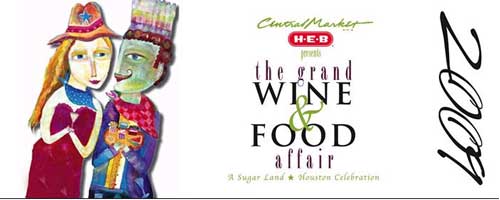
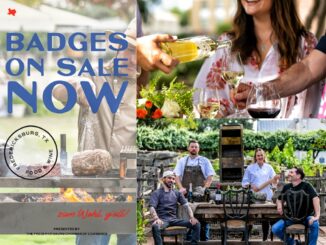

Be the first to comment